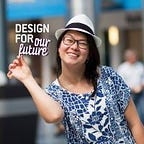Re-design of the Zurich transportation ticketing kiosk #ВсёПеределать
Working at a design agency is great and everything, with daily design challenges and complex UX problems to solve, but sometimes you need an intellectual break from regular client work. To squeeze some of those creative juices and add some diversity to my daily routine, I decided to pick up a challenge proposed by one of the leading UX studios of St Petersburg. The challenge is to re-design (in my case, re-UX) the ticketing kiosk of Zurich city transportation system. In this case, we aim to improve the customer journey of buying Zurich Card or Day Pass.
My first thought: use the app. But, as a tourist, you may not have a data plan when visiting Zurich.
So, let’s get this beast cracking.
All jokes aside, the machine really is a beast. It offers a full cocktail of options, starting from buying a single use ticket to leisure destinations, to topping up a SwissPass (a train membership card) and so on.
One of the problems is that the interface of the current machines is so two thousand and late. The colors are not very contrasting, and don’t get me even started on the emboss buttons. I mean, I get it, one of the richest countries may not have the needed budget to keep their infrastructure up to date, but even when you take the information hierarchy into account — it could have been better. Like here, the instruction for what action the user should perform on this screen is actually presented on the bottom right corner — the end of the user’s journey according to natural mapping.
Some of the other issues that could be optimized are:
- Lack of contrast in colors of text and buttons and background.
- Too many options presented at once. We all know the overwhelming paradox of choices, right?
- Poor hierarchy of information. Zurich card, for instance, is hidden so deep in the options that someone who has only seen the first screens will give up, thinking they cannot buy the Zurich card on these machines. In addition, on the left you need to select a station — it is about buying one single ticket. Whereas on the right you have all kind of other options, like bicycle tickets. The solution would be to hierarchize this information, so the user only sees things relevant to their goal. Subsequently, we must narrow it down to what the user might need and present relevant information consequently.
- Lack of visual icons/ indications -> especially to be easily recognizable by a multi-cultural audience.
- On the last step, it is not clear how to continue. There should be indication to look at the card screen or to insert money.
Information architecture
So, to tackle the challenge, I started card sorting the functionalities and constructing an information architecture that makes sense. For that, I decided to sequence the amount of information and choices presented in a top to bottom way. We start from broad choices and narrow down with every choice the user makes. This prevents the user from becoming overwhelmed as only relevant information is shown to them.
UX flow
I have further created simple wireframes. Disclaimer: As a UX architect by profession, I do not claim pixel perfection to be in my tool belt.
When the user approaches the kiosk, what is their main goal? Looking at all the functionalities, they can be clustered into three key categories, as in the following picture. In the case when the user wants to purchase Zurich Card or Day Pass, they would go for buying a ticket.
What kind of ticket?
If the user selects multiple use travel ticket, s/he is given the following options. (Disclaimer: I only base this on the screenshots I found online — if there happens to exist other types of Multi-use travel tickets, they should also be offered in this screen).
If the user selects “I don’t know what’s best for me”, the user is presented with a wizard, that contains a few questions (number of days they are traveling, area as in number of zones, whether they intend to visit museums) and a smart algorithm will calculate and recommend the best option for their needs.
A simple description based on the selected options is shown, with an opportunity to read more if necessary. The user can also select ticket class.
When the user taps on an option, there is a micro interaction shown for a second before moving to next screen to give feedback to the user of their action.
The progress bar indicates where the user is at in the process and shows the choices s/he has made. They can also see how many more steps are upcoming.
They can select the date they are traveling,
…and the payment method they desire to use.
The screen gives further instruction what the user should do. If the user selected cash, the instruction is to insert their cash in the machine. The accepted bills and coins are displayed.
If the user selected card, the accepted cards would be shown.
2 cents more: In terms of the interface of the physical side of the kiosk, there can also be some improvements. For instance, when the user selects the payment method (cash or card) only the relevant slots would be illuminated. The slots for coins and bills could be grouped together, as they represent one means of payment — cash.
In conclusion, a couple of pretty pictures from my amazing trip to Zurich :)
